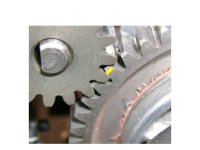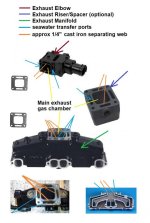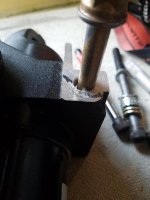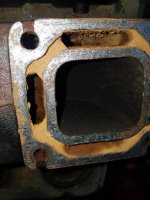Thanks Rick for discussing my issues. First thing, I do not like 1-2 tooth contact, no gear is designed like,
No disagreement there!
obviously it works as long as there is no hydro lock. It will be sheared of with hydro lock due to inertia effect. It should just stop turning crank with no damage unless a different cylinder fires and bend the rod.
BTW, I worked for GM for 35 years as an engineer. I think the block is bored correctly
I don't think that any of us had a concern about the cylinders being bored correctly.
My comment pertained to the machining of all areas of the cylinder block... including the starter motor bolt threads!
but merc and after market folks just did not do it right.
Here is a picture of starter hole elongation that made it 2 mm closer to ring gear.
Being an engineer, you certainly know why the starter motor nose housing mounting bolt bores are to be a tolerance specific size.
The knurled areas of the bolts are to serve as alignment dowels.
When/if the nose housing bolt bores are enlarged, this dowel/alignment affect is removed from the equation.
Now the concerns will be:
.........will the starter motor torque now shift the alignment, even while the bolts are tight?
.........will the starter motor stay in place while undergoing the torque, even while the bolts are tight?
.........with the bores elongated, and if the starter motor nose housing was to shift, now it can shift even further than it could before!
After work, removed the riser and picture of one is attached.
I believe that you mean exhaust elbow. (see my image in post #38.)
they both look perfect, no rust thru as long as I can see with camera.
Agreed..... the transfer ports and the material between them and the main exhaust chamber look to be OK.
Suggestion:
*** take the exhaust components in to a machine shop for cleaning a magnafluxing. The magnafluxing process will find any cracks.
If need be, a machinist can true the mating surfaces by using a machine shop surface sander. It should take him no longer than 5 minutes per each surface!
I think changing manifold and riser every 5 years is total non-sense. Look at mine, they are 32 years old.
A 5 year interval is a general rule and/or suggestion.
But again, see *** above!
Gaskets were both in pretty bad shape as that is my fault. I had to remove Elbows a couple o times but did not change the gaskets.
Do as you wish...... however, all gaskets and/or O-rings are One-Time-Use items.
Never try to re-use them!
Gaskets will be compressed beyond re-use, and O-rings will have taken a "set" and will be beyond re-use!





